Advances in Pure Mathematics
Vol. 3 No. 6 (2013) , Article ID: 36377 , 3 pages DOI:10.4236/apm.2013.36073
The Equivalence of Certain Norms on the Heisenberg Group
Department of Mathematics, Universty of Ibadan, Ibadan, Nigeria
Email: murphy.egwe@ui.edu.ng, me−egwe@yahoo.co.uk
Copyright © 2013 M. E. Egwe. This is an open access article distributed under the Creative Commons Attribution License, which permits unrestricted use, distribution, and reproduction in any medium, provided the original work is properly cited.
Received April 25, 2013; revised May 29, 2013, accepted June 23, 2013
Keywords: Heisenberg Group; Heisenberg Norms; Equivalent Norms; Homogeneous Group
ABSTRACT
Let  be the
be the  -dimensional Heisenberg group. In this paper, we shall give among other things, the properties of some homogeneous norms relative to dilations on the
-dimensional Heisenberg group. In this paper, we shall give among other things, the properties of some homogeneous norms relative to dilations on the  and prove the equivalence of these norms.
and prove the equivalence of these norms.
1. Introduction
The Heisenberg group (of order ),
),  is a noncommutative nilpotent Lie group whose underlying manifold is
is a noncommutative nilpotent Lie group whose underlying manifold is  with coordinates
with coordinates  and group law given by
and group law given by

Setting , then
, then 
forms a real coordinate system for . In this coordinate system, we define the following vector fields:
. In this coordinate system, we define the following vector fields:

The set  forms basis for the left invariant vector fields on
forms basis for the left invariant vector fields on  [1]. These vector fields span the Lie algebra
[1]. These vector fields span the Lie algebra  of
of  and the following commutation relations hold:
and the following commutation relations hold:

Similarly, we obtain the complex vector fields by setting
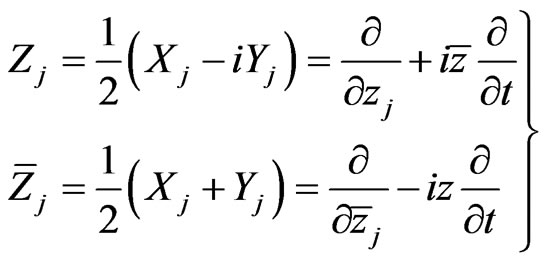
In the complex coordinate, we also have the commutation relations

If we identify  with
with  then each element of
then each element of  is given by
is given by  and the group law becomes
and the group law becomes

where  denotes the scalar product of
denotes the scalar product of  The neutral element
The neutral element  of
of  is of the form
is of the form  and the inverse element
and the inverse element

The centre of  is given by
is given by

and therefore isomorphic to the additive locally compact topological group  The Haar measure on
The Haar measure on  is the Lebesgue measure
is the Lebesgue measure  on
on  [1].
[1].
On the group, we introduce the group 
of dilations defined for each element  of
of 
by  on the complex coordinates and by
on the complex coordinates and by  on the real coordinates. The family of dilations
on the real coordinates. The family of dilations  forms a one-parameter group of automorphisms of
forms a one-parameter group of automorphisms of  Indeed, we have the following properties of this family of dilations.
Indeed, we have the following properties of this family of dilations.
(i) 
(ii)  Moreover(iii)
Moreover(iii)  Properties (i) and (iii) can be easily seen [2,3]. To see (ii), we notice that: For
Properties (i) and (iii) can be easily seen [2,3]. To see (ii), we notice that: For  and
and  we have
we have
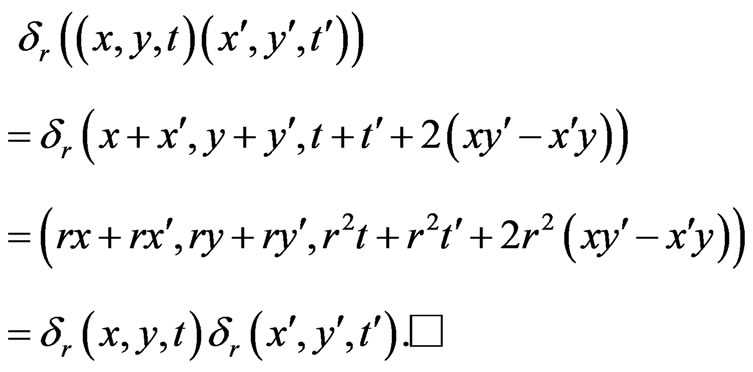
With these dilations as automorphisms of 
 becomes a stratified Lie group whose generators are the defined vector fields [4]. Similarly,
becomes a stratified Lie group whose generators are the defined vector fields [4]. Similarly,  and its Lie structure equipped with this family of dilations is a homogeneous group of dimension
and its Lie structure equipped with this family of dilations is a homogeneous group of dimension  [5].
[5].
2. Homogeneous Norms on 
Definition 2.1: A norm on the Heisenberg group, is a function
 (2.1)
(2.1)
satisfying the following properties:
(i) ,
,
(ii) ,
,
(iii) (iv)
(iv)  for all
for all  and
and  where
where 
The value  is called the Heisenberg distance of
is called the Heisenberg distance of  from the origin and
from the origin and
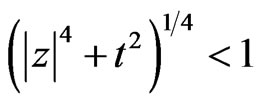 is the Heisenberg unit ball [6]. We say the norm in
is the Heisenberg unit ball [6]. We say the norm in  is homogeneous of degree
is homogeneous of degree  with respect to the dilations if for any
with respect to the dilations if for any  we have
we have . The value given by
. The value given by

is the popular Koranyi norm on  which is always positive definite [7].
which is always positive definite [7].
Property (i) is the homogeneity of the Heisenberg norm while property (iv) indicates the subadditivity of the Heisenberg norm. The proof of properties (i)-(iii) is trivial and that of (iv) can be found in [8].
Following [9], we shall further define the following norms on . For
. For  define
define
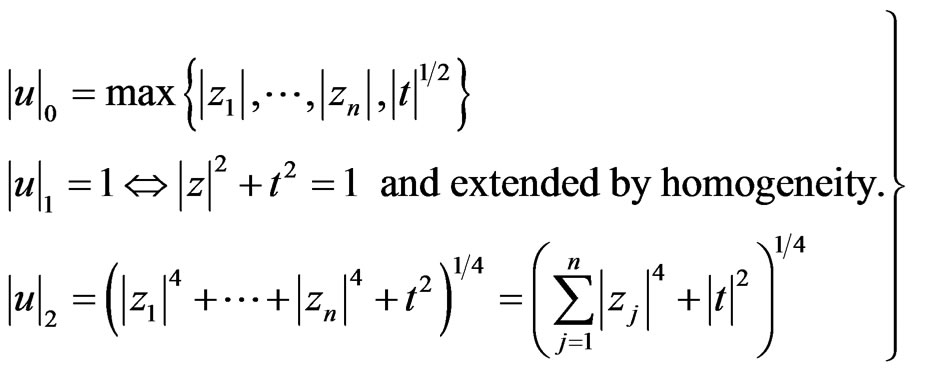 (2.2)
(2.2)
We notice that  gives a choice which is not smooth away from the origin. The norm
gives a choice which is not smooth away from the origin. The norm 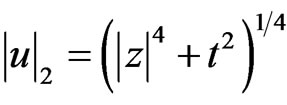
and the properties above do not uniquely determine the norm. For if  is positive, smooth away from 0, and homogeneous of degree 0 in the Heisenberg group dilation structure, then
is positive, smooth away from 0, and homogeneous of degree 0 in the Heisenberg group dilation structure, then  gives another norm [10].
gives another norm [10].
Since  it can be equipped with the Euclidean norm in
it can be equipped with the Euclidean norm in  denoted by
denoted by  and defined by
and defined by

We have the following:
Proposition 2.3 [10]: For 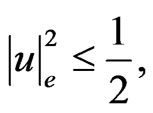 we have
we have

We notice however, that this norm is not homogeneous. In what follows, we show that homogeneous norms on the Heisenberg group are equivalent following [10].
Lemma 2.4: Let  be a homogeneous norm on
be a homogeneous norm on  Then, there is a constant
Then, there is a constant  such that
such that

where  is as defined in (2.2).
is as defined in (2.2).
Proof: Now observe that  is homogeneous of degree
is homogeneous of degree  and by hypothesis,
and by hypothesis,  is homogeneous. Let
is homogeneous. Let
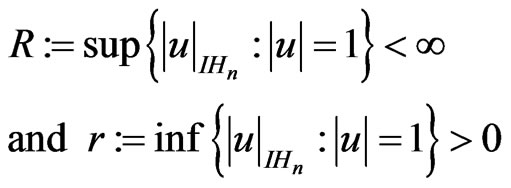
and set

Now, if we identify  as
as  then sup is actually a maximum and inf is a minimum. Thus
then sup is actually a maximum and inf is a minimum. Thus  exists and the inequality in the theorem holds. This is possible since
exists and the inequality in the theorem holds. This is possible since  and
and  follows from the fact that
follows from the fact that  is a compact subset of
is a compact subset of  not containing the origin and
not containing the origin and  is a continuous function which is strictly positive in
is a continuous function which is strictly positive in 
Corollary 2.5: For every fixed homogeneous norm  on
on  there exists a constant
there exists a constant  such that
such that

Proof: We notice that the norm function is continuous and therefore,  Now consider the the group of dilations
Now consider the the group of dilations  on
on  Then
Then 
is an automorphism of  Therefore, by Lemma 2.4, the result follows.
Therefore, by Lemma 2.4, the result follows.
Theory 2.6: Any two homogeneous norms on  are equivalent.
are equivalent.
Proof: We apply the previous method as follows: Let

and define  by
by

Then

is obviously continuous by the homogeneity property with respect to  Since
Since  is bounded with respect to
is bounded with respect to  attains it bounds and therefore,
attains it bounds and therefore,  exists. Thus,
exists. Thus,  such that
such that  If
If 
then there exists  such that
such that  so that
so that

The theorem then follows by Lemma 2.4.
REFERENCES
- R. Howe, “On the Role of the Heisenberg Group in Harmonic Analysis,” Bulletin of the American Mathematical Society, Vol. 3, 1980, pp. 821-843. doi:10.1090/S0273-0979-1980-14825-9
- D. Muller, “Analysis of Invariant PDO’s on the Heisenberg Group,” ICMS-Instructional Conference, Edinburg, 6-16 April 1999, pp. 1-23.
- M. E. Egwe, “Aspects of Harmonic Analysis on the Heisenberg Group,” Ph.D. Thesis, University of Ibadan, Ibadan, 2010.
- A. Bonfiglioli, E. Lanconelli and F. Uguzzoni, “Stratified Lie Groups and Potential Theory for Their Sub-Laolacians (Springer Monographs in Mathematics),” Springer, Berlin, 2007.
- G. B. Folland and E. M. Stein, “Estimate for the Complex and Analysis on the Heisenberg Group,” Communications on Pure and Applied Mathematics, Vol. 27, No. 4, 1974, pp. 429-522. doi:10.1002/cpa.3160270403
- G. B. Folland, “A Fundamental Solution for a Subelliptic Operator,” Bulletin of the American Mathematical Society, Vol. 79, No. 2, 1973, p. 373. doi:10.1090/S0002-9904-1973-13171-4
- J. R. Lee and A. Naor, “Lp Metrics on the Heisenberg Group and the Geomans-Linial Conjecture,” Proceedings of the 47th Annual IEEE Symposium on Foundations of Computer Science, Berkeley, 21-24 October 2006, pp. 99-108.
- J. Cygan, “Subadditivity of Homogeneous Norms on Certain Nilpotent Lie Groups,” Proceedings of the American Mathematical Society, Vol. 83, 1981, pp. 69-70. doi:10.1090/S0002-9939-1981-0619983-8
- N. Laghi and N. Lyall, “Strongly Singular Integral Operators Associated to Different Quasi-Norms on the Heisenberg Group,” Mathematical Research Letters, Vol. 14, No. 5, 2007, pp. 825-238.
- S. G. Krantz, “Explorations in Harmonic Analysis with Applications to Complex Function Theory and the Heisenberg Group,” Birkhauser, Boston, 2009.

